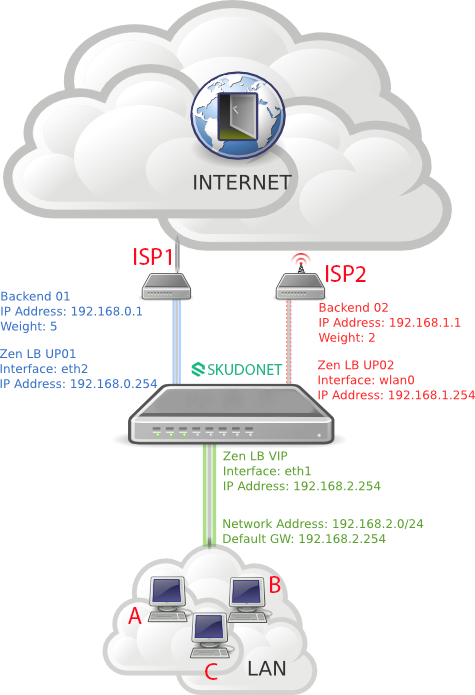Datalink Service Load Balancing (DSLB), also known as Uplinks Load Balancing, allows you to create highly available and scalable WAN Uplinks at layer 3 of the OSI model.
DSLB farms are route-based farms where the backends are uplink routers or gateways. This farm type is typically used to share several WAN router access channels using the load balancer as an uplink channel multiplexer. This means that DSLB farms can be used to create highly available communication links, or to increase the bandwidth between the router’s backend links.
The diagram below shows an example of load balancing several uplinks with different weights:

Here is an explanation of the image above.
Scenario 1: Employee A is downloading a large file. The DSLB farm detects the high-bandwidth request and directs it to the connection with the highest available bandwidth, ISP1.
Scenario 2: Another employee B is checking email, which requires less bandwidth. The DSLB farm recognizes this and routes the email traffic to the less congested connection, ISP2.
Scenario 3: A group of employees C, is participating in a video conference. The DSLB farm prioritizes this real-time traffic and distributes it across both connections, ensuring a smooth and uninterrupted video experience.
By distributing traffic intelligently, uplink load balancing optimizes network performance, prevents congestion, and ensures that critical applications always have the bandwidth they need.
DSLB Farm list
The DSLB Farms List shows all of the DSLB farms that are currently configured.
Actions: The following actions are available for each farm in the table:

- Create Farm: Creates a new DSLB farm.
- Restart: Reboots the services on a DSLB farm.
- Stop: Stops the services on a DSLB farm.
- Start: Starts the services on a DSLB farm.
- Delete: Stops the services on a DSLB farm and deletes the farm’s configuration.
- Edit: Modifies the settings of a farm, creates new services, and applies those changes to the backends.
DSLB Farms Table
The DSLB Farms Table shows a list of all of the DSLB farms that are currently configured.

Each farm is listed with the following information:
Name: A unique name for the farm.
Virtual IP: The IP address that the farm uses to receive incoming traffic. This IP address could be moved to another node in the cluster and could act as the default gateway for the local network.
Interface: The network interface that the farm uses to receive incoming traffic and distribute it to the WAN networks.
Status: The current status of the farm, which is indicated by one of the following colors:
- Green: The farm is running and all backends are UP.
- Red: The farm is stopped.
- Yellow: The farm is running but needs to be restarted to apply recent changes.
- Black: The farm is running but there are no backends available or they are in maintenance mode.
- Blue: The farm is running but at least one backend is down.
- Orange: The farm is running but at least one backend is in maintenance mode.
Next Article: DSLB | Farms | Create

